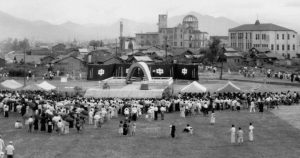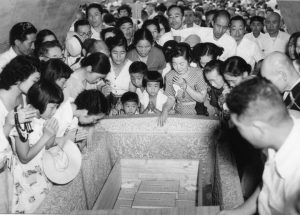Documenting Hiroshima 80 years after A-bombing: August 6, 1952, Cenotaph for the A-bomb Victims unveiled
Feb. 24, 2025
Humanity’s pledge — “For we shall not repeat the evil”
by Kyosuke Mizukawa, Senior Staff Writer
On August 6, 1952, the first anniversary of the atomic bombing following the end of Japan’s occupation, the Peace Memorial Ceremony was held at the development site for Hiroshima’s Peace Memorial Park (in the city’s present-day Naka Ward). At the ceremony, children who had lost their parents in the atomic bombing unveiled the Cenotaph for the A-bomb Victims. An epitaph was inscribed on the cenotaph’s stone chamber, in which was stored a register of A-bomb victims’ names.
Act based on reflection
The ceremony, co-hosted by the Hiroshima City government and the Hiroshima Peace Memorial Service Committee, was attended by around 1,000 people. Hiroshima City Mayor Shinso Hamai read aloud the Peace Declaration for the first time in front of the cenotaph. In the declaration, Mr. Hamai recalled the bombing and said, “Looking back, I cannot help but shudder at the gravity of the mistakes of which humanity is capable.” He pledged that “we” would turn our reflection of the past into action. The inscription, “Let all the souls here rest in peace; For we shall not repeat the evil,” was engraved on the granite stone chamber situated under the cenotaph.
The inscription was composed by Tadayoshi Saika, professor of English literature at Hiroshima University. According to Mr. Saika’s personal account, in July, Chimata Fujimoto, a former student of Mr. Saika who was working in the mayor’s office, paid a visit to the teacher to discuss Mr. Hamai’s desire “to engrave words of prayer and a vow” on the monument. After about two hours, Mr. Saika murmured softly, “Rest in peace; for we shall not repeat the mistake.” The inscription was refined and finished the following day.
As described in his book Genbaku Shicho (in English, ‘A-bomb mayor’), published in 1967, Mr. Hamai interpreted the proposed inscription as a vow from the perspective of human history to not wage war and “considered it to be a good epitaph.” Believing the use of science for slaughter is a grave error for humankind, he hoped that “all those who bow in front of the monument will, as members of the human race, take a share of the responsibility for this mistake and offer their apologies to the victims,” leading to reflection and the determination required to realize world peace.
English translation of inscription questioned
Mr. Saika agreed to take on the job of writing the inscription using calligraphy. The Chugoku Shinbun dated July 23, 1952, reported that he had “made an effort to represent the feelings of Hiroshima’s citizens both with words and calligraphic style.” Also involved in the work of translating the epigraph into English, Mr. Saika chose “we” to serve as the subject of the inscription, a word that had not been included in the original Japanese.
However, doubts about the inscription in English soon arose. On November 3, a legal scholar from India, Radhabinod Pal, who was visiting the cenotaph in conjunction with his participation in an international conference held in Hiroshima, took the subject “we” to mean the Japanese people and argued that, after all, it had not been the Japanese who had dropped the atomic bombs. While the International Military Tribunal for the Far East (also known as the Tokyo District Court’s “A-bomb trial”), in which he served as one of the judges, had prosecuted the wartime leaders of Japan in its ruling handed down in 1948, it had not addressed the issue of the atomic bombings by the U.S. military.
Moreover, Mr. Pal went on to state that the hands of those who dropped the atomic bombs were still not clean. His statements were carried on the front page of the Chugoku Shimbun published the following morning. When Mr. Hamai met with Mr. Pal, who had expressed concern that the inscription seemed to condone acts of atrocity, the mayor explained that its intended “meaning was ‘a vow to never wage war again,’” in a description published in the book Genbaku Shicho.
With respect to the issue of the register of A-bomb victims’ names offered at the ceremony in 1952, which also marked completion of the Cenotaph for the A-bomb Victims, the Hiroshima City government continued its survey to identify the names of A-bombing victims, which it had initiated in the spring of 1951, the year before the ceremony.
The city government sent out survey forms to prefectures throughout Japan and encouraged bereaved families to record the names of victims. It also sent the forms to schools and other organizations in Hiroshima City. However, the survey was difficult for one local government to handle, and the city ended up calling for urgent help around one month before the register was to be stored inside the stone chamber. An article in the Chugoku Shimbun dated July 4, 1952, reported that the city had revealed, “A considerable number of victims’ names are missing from the register.”
The register stored inside the chamber at that time contained the names of 57,902 victims. The total number of A-bomb victims dying by the end of December 1945, is now estimated by Hiroshima City to have been around 140,000 people (with a margin of error of ± 10,000). Thus, the register was far from an accurate view of the reality of the devastation from the atomic bombing.
(Originally published on February 24, 2025)









